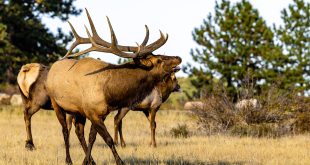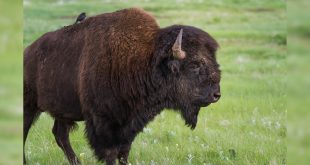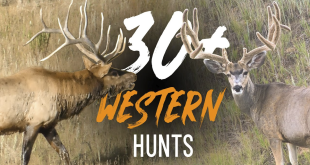The New Mexico Department of Game & Fish (NMG&F) is beginning to finalize the next four-year rule cycle beginning April 1st, 2023. Even though the deer and elk rule cycle will not be voted on by the Commission until October, not much is expected other than the passage of the muzzleloader rule. This effectively eliminates scopes from all of the muzzleloader hunts, thereby making them a primitive weapons hunt. This basically applies to all species.
The Commission voted on and passed the exotics rule for the next four-year cycle with some minor shifts in licenses but again the major rule is the elimination of scopes on all muzzleloader hunts.
I applaud the NMG&F for standing up for all hunters and for trying to keep the status quo with the current split on the license structure, meaning 84 percent go to residents, 6 percent to non-residents and 10 percent to hunters hiring an outfitter. Especially for bighorn sheep hunters, (both Rockies and Deserts). There are some organizations that are attempting to circumvent this system by saying that the NMG&F has changed the rule to allow for more non-resident hunts. These organizations are spreading misinformation to the Game Commission which in turn has the potential to vote against the NMG&F on the next rule cycle.
Because none of the current bighorn sheep ram hunts have more than five tags by individual hunt codes, the argument by the NMWF is that all of these tags should go to residents by following the 84/6/10 split. The way that the current structure is set up by the NMG&F is that all of the Rocky Mountain ram tags and the Desert ram tags are pooled into one hunt code for each. This creates a pool of 26 Rocky Mountain bighorn sheep ram tags and 24 for the desert sheep and the existing structure allows for the 84/6/10 spit.
The good news is that the Commission voted on and accepted the current license structure as proposed by the NMG&F with the 84/6/10 split. However, this is only for the next two years for the bighorn sheep so this battle will be revisited again in the very near future.
 Eastmans' Official Blog | Mule Deer, Antelope, Elk Hunting and Bowhunting Magazine | Eastmans' Hunting Journals
Eastmans' Official Blog | Mule Deer, Antelope, Elk Hunting and Bowhunting Magazine | Eastmans' Hunting Journals






The falsehoods and misinformation are in your article and from organizations that advocate for nonresident preference, not from the organizations and people like me that advocate for New Mexico residents.
Your article is incorrect in implying that the game commission has anything to do with the 84/6/10 draw tag allotment. The draw allotment is set by the legislature by statute. The commission has the authority over rules, not statutes. The commissions impact on the statutory 84/6/10 quota statute is when it does an end around of the statutory quota. As it does with bighorns. As you point out, under the quota statute there would be no nonresident or outfitter bighorn tags. So the commission in its apparently unlimited desire to take tags from resident hunters concocted the rule that is specifically designed to avoid quota statute to artificially generate nonresident and outfitted bighorn permits that do not exist by statute. For elk it is even worse. The combination of the elk rule and the EPLUS rule make over 13,800 elk permits every year private and not subject to the quota statute. The EPLUS system plus the outfitter set aside makes it so only 55% of all NM elk licenses issued last year (and every year) are issued to residents that have not paid a landowner or outfitter to obtain the tag. And only about 63% of all elk licenses are issued to residents by all channels (resident draw, outfitter draw set aside, and landowner permits). That is a far cry from the 84% resident plus whatever portion residents are awarded through the outfitter set aside specified by the quota statute. Due to commission rules the real percentages of licenses awarded to NM residents is a fiction compared to the percentages specified by the quota statute. If simply pointing out this reality is “misinformation” I don’t know what your definition of reality is. I know we live in the post truth era, but it doesn’t do much for your credibility to publish such garbage.
Anyway, it’s New Mexican’s wildlife. We decide how much to share with nonresidents. Westerners that push for nonresident preferences in other western states are missing the big picture. Western states have the bulk of the public land. We have species like elk, sheep, mule deer, pronghorn that hunters from all over the country want to hunt. There is huge demand for our licenses. Westerners are not clamoring to go to Ohio, Iowa, Texas, etc to hunt. We and other state residents do not pose a threat to the ability of non western state residents ability to hunt in their states. But they pose a huge threat to western state resident’s ability to hunt. Without strict nonresident limits in western states western hunters would become the only hunters that would basically be nonresidents everywhere when it comes to hunting opportunity. Westerners that are strong nonresident preference advocates like Eastmans are saying that they want westerners to be the only hunters that don’t have a place to hunt that is uniquely for them, their home states. Certainly that’s not a horrible thing for people like me and people like Eastmans that can afford to apply and travel and hunt all over the country and the world. But for the average western hunter that can’t afford to travel every year to hunt, it is a disaster. Their children won’t learn to hunt because they can’t get tags. They will not grow to care about wildlife and hunting. It doesn’t take much imagination to understand the many ways it is bad for western state residents to have the hunting rug pulled out from underneath them.